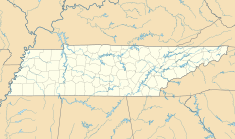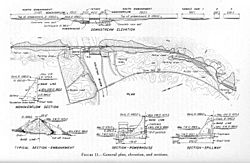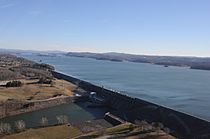Cherokee Dam facts for kids
Quick facts for kids Cherokee Dam |
|
|---|---|

Cherokee Dam
|
|
|
Location of Cherokee Dam in Tennessee
|
|
| Official name | Cherokee Dam |
| Location | Jefferson and Grainger counties, Tennessee, United States |
| Coordinates | 36°9′58″N 83°29′54″W / 36.16611°N 83.49833°W |
| Construction began | August 1, 1940 |
| Opening date | December 5, 1941 |
| Operator(s) | Tennessee Valley Authority |
| Dam and spillways | |
| Impounds | Holston River |
| Height | 175 feet (53 m) |
| Length | 6,760 feet (2,060 m) |
| Reservoir | |
| Creates | Cherokee Lake |
| Power station | |
| Commission date | 1942-1953 |
| Type | hydroelectric |
| Turbines | 2 x 35 MW, 2 x 33 MW Francis-type |
| Installed capacity | 136 MW |
The Cherokee Dam is a large hydroelectric dam built on the Holston River in Grainger County, Tennessee and Jefferson County, Tennessee. The Tennessee Valley Authority (TVA) built and operates this dam. It was constructed very quickly in the early 1940s. This was to help provide a lot of electricity during World War II.
Cherokee Dam stands 175 feet (53 m) tall. It creates a huge lake called Cherokee Lake, which covers about 28,780 acres (11,650 ha). The dam can produce 135,200 kilowatts of power. The dam was named after the Cherokee, a Native American tribe. They lived in much of East Tennessee when the first European settlers arrived.
Where is Cherokee Dam?
The Holston River is formed when its North Fork and South Fork join together in Kingsport, Tennessee. From there, the river flows southwest for over 140 miles (230 km). It then meets the French Broad River in Knoxville, Tennessee to form the Tennessee River.
Cherokee Dam is located about 52 miles (84 km) upstream from where the Holston River joins the Tennessee River. The dam was built just below where Mossy Creek flows into the Holston. This area looks like a "T" shape.
Cherokee Lake stretches for 59 miles (95 km) from the dam. It reaches towards the John Sevier Combined Cycle Plant near Rogersville, Tennessee. The lake covers parts of Jefferson, Grainger, Hamblen, and Hawkins counties. You can find Tennessee State Route 92 crossing the Holston River just downstream from the dam.
Why and How Cherokee Dam Was Built
In 1940, World War II was happening in Europe. The United States government realized it needed to make its military stronger. This meant producing a lot more aluminum, which needed a huge amount of electricity. Many aluminum factories were in the Tennessee Valley.
To get this power, the Tennessee Valley Authority (TVA) suggested building a new dam on the Holston River. They had already picked the "Mossy Creek site" and had some early plans. The TVA also proposed building a new coal plant and making existing dams produce more power.
Congress quickly approved the money for this project in July 1940. President Franklin D. Roosevelt signed it into law on July 1, 1940. Construction on Cherokee Dam started the very next day!
Building the dam was a huge job.
- The TVA had to buy over 45,158 acres (18,275 ha) of land.
- Almost 6,000 acres (2,400 ha) of wooded land needed to be cleared.
- 875 families had to move from their homes.
- 51 cemeteries were relocated.
- A historic tavern in Bean Station, Tennessee was also moved, as it was the only major community that would be flooded.
- The water supplies for Jefferson City and Morristown, Tennessee had to be changed.
- About 99 miles (159 km) of roads had to be moved.
- Fourteen new bridges were built, and five old ones were raised.
- Three smaller earthen dams were built nearby to fill gaps in the land.
Because Congress removed many rules about getting building materials, the construction went very fast. On December 5, 1941, the dam was finished. The gates were closed, and the lake began to fill. Power generation started on April 16, 1942. This was less than two years after the dam was first planned!
How Cherokee Dam Works and What It Does
Cherokee Dam is a "gravity-type" concrete dam. This means its heavy weight holds back the water. It has nine gates at the top (crest gates) and eight lower gates (sluice gates). The sluice gates help control the water when the lake level is low.
The dam has four powerful hydroelectric generators. Together, they can produce 135,200 kilowatts of electricity. Cherokee Lake can hold a lot of water to prevent floods, about 749,406 acre-feet (924,379,000 m3). The lake's water level usually changes by about 27 feet (8.2 m) in a typical year. The dam was designed so that navigation locks (for boats to pass through) could be added later if needed.
While making electricity is the main job of Cherokee Dam, it also helps control floods. Before the 1930s, flooding was a big problem in the Tennessee Valley.
Cherokee Lake is also a popular spot for fun activities!
- You can visit Panther Creek State Park there.
- There are many smaller parks and 20 public boat launches.
- The Tennessee Wildlife Resources Agency regularly adds fish like walleye, crappie, and hybrid striped bass to the lake. This makes it a great place for fishing.
In 2018, when Hurricane Florence was approaching, the TVA released water from Cherokee Dam's spill gates. This was the first time these gates had been used since 1994.




